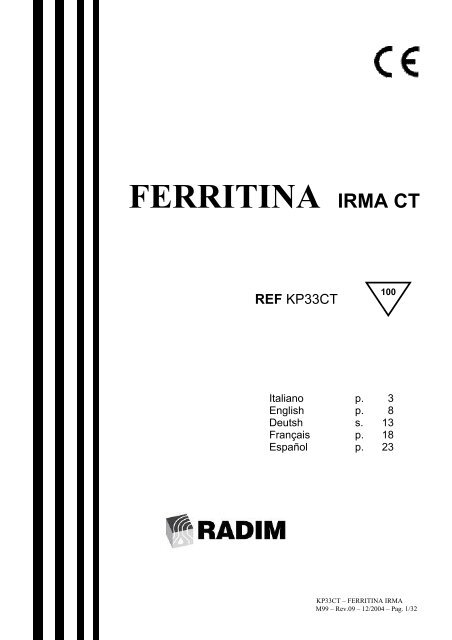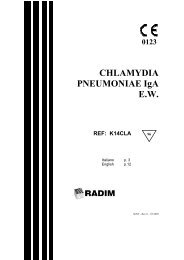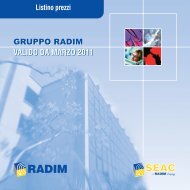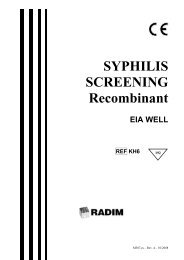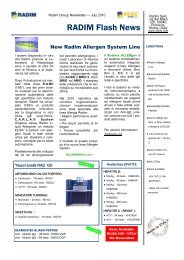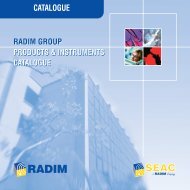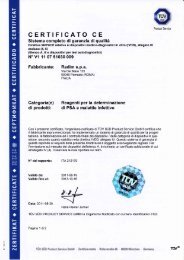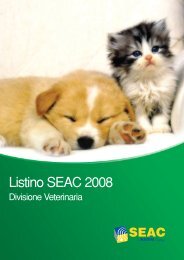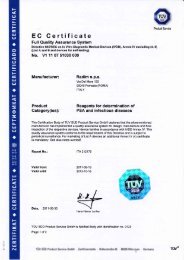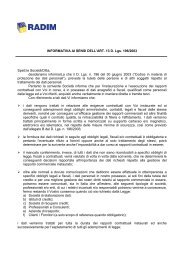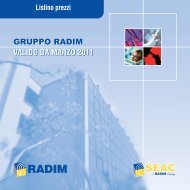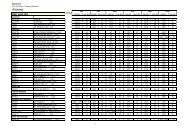ferritina irma ct ref
ferritina irma ct ref
ferritina irma ct ref
Create successful ePaper yourself
Turn your PDF publications into a flip-book with our unique Google optimized e-Paper software.
FERRITINA IRMA CT<br />
REF KP33CT<br />
100<br />
Italiano p. 3<br />
English p. 8<br />
Deutsh s. 13<br />
Français p. 18<br />
Español p. 23<br />
KP33CT – FERRITINA IRMA<br />
M99 – Rev.09 – 12/2004 – Pag. 1/32
Reagenti del Kit - Kit Reagents - Kit Reagenzien - Rea<strong>ct</strong>ifs de la Trousse -<br />
Rea<strong>ct</strong>ivos del Kit.<br />
Reag, Reac Quant, Cant Stato fisico,<br />
Physical state,<br />
Aggregatzustand,<br />
État physique,<br />
CT<br />
CAL<br />
CONJ I 125<br />
WASH<br />
Estado fisico<br />
100 Pronte per l'uso, Ready for use,<br />
Gebrauchsfertig, Prêt à l'emploi, Listo<br />
7 x 1 mL<br />
para el uso.<br />
Pronto per l'uso, Ready for use,<br />
Gebrauchsfertig, Prêt à l'emploi, Listo<br />
para el uso.<br />
1 x 50 mL Pronto per l'uso, Ready for use,<br />
Gebrauchsfertig, Prêt à l'emploi, Listo<br />
para el uso.<br />
1 x 50 mL Conc, Konz<br />
KP33CT – FERRITINA IRMA<br />
M99 – Rev.09 – 12/2004 – Pag. 2/32
DOSAGGIO IMMUNORADIOMETRICO PER LA DETERMINAZIONE QUANTITATIVA DELLA<br />
FERRITINA NEL SIERO UMANO<br />
PER USO DIAGNOSTICO IN VITRO<br />
APPLICAZIONI CLINICHE<br />
La molecola della Ferritina è costituita da 24 subunità proteiche, ciascuna con un peso molecolare di<br />
20.000 D. La funzione primaria della Ferritina è quella di accumulare il ferro intracellulare proteggendo la<br />
cellula dagli effetti tossici del metallo libero e costituendo una riserva di ferro rapidamente mobilizzabile.<br />
La maggior parte della Ferritina nell'organismo si trova nelle cellule del fegato e nelle cellule del sistema<br />
reticolo endoteliale di fegato, milza e midollo osseo, quantità minori si trovano nel cuore, nel pancreas e<br />
nel rene. Piccole, ma significative quantità di Ferritina si trovano nel siero umano. La funzione della<br />
Ferritina sierica non è nota, ma esiste una stretta correlazione tra la concentrazione nel siero di questa<br />
proteina e i depositi di ferro dell'organismo: il dosaggio della Ferritina sierica rappresenta quindi il<br />
metodo più semplice e meno invasivo per la sua valutazione. L'andamento delle concentrazioni della<br />
Ferritina sierica riflette le modificazioni dell'equilibrio corporeo dovute all'età e al sesso. Per individui<br />
normali, i livelli medi, lievemente più elevati alla nascita, si abbassano durante l'infanzia fino al<br />
raggiungimento della pubertà. Successivamente, nei maschi, si ha un progressivo aumento dei depositi<br />
corporei di ferro e, proporzionalmente, della <strong>ferritina</strong> sierica, mentre, nelle donne in età feconda, si<br />
osservano valori più bassi e stabili ed un aumento della ferritinemia solo dopo la menopausa. Valori di<br />
Ferritina inferiori alla norma indicano, con sicurezza, carenza di ferro e permettono la diagnosi<br />
differenziale tra anemia sideropenica ed anemia dovuta ad altre cause. Il sovraccarico marziale, sia<br />
esso dovuto ad aumentato assorbimento di ferro, come nell'emocromatosi idiopatica o a trasfusioni<br />
multiple, determina un incremento della Ferritina sierica spesso molto superiore alla soglia dei valori<br />
normali. Un aumento della Ferritinemia si osserva anche in altre condizioni patologiche quali: epatopatie,<br />
processi infettivi ed infiammatori, leucemia, linfoma di Hodgkin ed altre forme neoplastiche.<br />
PRINCIPIO DEL METODO<br />
Il presente metodo utilizza due anticorpi monoclonali anti-Ferritina che riconoscono due epitopi diversi<br />
della molecola. Un anticorpo è adsorbito su fase solida (provette sensibilizzate), l'altro, marcato con<br />
Iodio 125, viene utilizzato come coniugato. Il campione da dosare e l'anticorpo marcato vengono incubati<br />
contemporaneamente nella provetta sensibilizzata. In tal modo l'anticorpo marcato viene legato alla fase<br />
solida mediante l'antigene presente nei calibratori o nel campione, in quantità direttamente proporzionale<br />
alla concentrazione di quest'ultimo. Al termine dell'incubazione, l'eccesso dei reagenti rimasto in<br />
soluzione viene rimosso mediante aspirazione e lavaggi. La radioattività residua nelle provette viene<br />
misurata in un contatore di raggi gamma.<br />
REAGENTI CONTENUTI NEL KIT: PREPARAZIONE E STABILITA'<br />
− I reagenti sono sufficienti per 100 tubi.<br />
− Il kit deve essere conservato a 2-8°C.<br />
− La data di scadenza di ciascun reagente é indicata sulla rispettiva etichetta.<br />
1 - CT Provette Sensibilizzate: 100 provette sensibilizzate con un anticorpo monoclonale anti-Ferritina<br />
(topo). Le provette non utilizzate devono essere riposte nella loro custodia accuratamente richiusa a 2-<br />
8°C.<br />
2 - CAL Calibratori: 7 flaconi (1 mL) di Ferritina (fegato umano) in tampone fosfato e BSA alle seguenti<br />
concentrazioni: 0, 5, 20, 50, 250, 1000 e 2000 ng/mL. Conservante: NaN3 (< 0.1%). Pronto per l'uso. Il<br />
Calibratore è stato calibrato sulla preparazione di Standard Internazionale 94/572.<br />
N.B.: verificare sempre l'esatta concentrazione sul foglio di C.Q.<br />
3 - CONJ I 125 Coniugato Radioattivo: 1 flacone (50 mL) di 125 I-anti Ferritina monoclonale in tampone<br />
fosfato e BSA. Contenuto di radioattività: 444 KBq. Conservante: NaN3 (< 0.1%). Pronto per l'uso e<br />
colorato in rosso.<br />
6 - WASH Soluzione di lavaggio (concentrata): 1 flacone (50 mL) di Tris HCl e Tween 20.<br />
Conservante: NaN3 (< 0.1%). Prima dell'uso diluire la soluzione in rapporto 1:10 con H2O distillata. La<br />
soluzione diluita è stabile 2 mesi a 2-8°C.<br />
KP33CT – FERRITINA IRMA<br />
M99 – Rev.09 – 12/2004 – Pag. 3/32
MATERIALE NECESSARIO MA NON FORNITO<br />
− Provette in plastica monouso (12x75 mm).<br />
− Portaprovette.<br />
− Micropipette automatiche a punte intercambiabili a volume variabile.<br />
− Cilindro graduato.<br />
− Dispensatore da 1 mL.<br />
− Agitatore orbitale, regolabile a 150 rpm.<br />
− Pompa aspirante oppure apparecchiatura automatica equivalente.<br />
− Contatore gamma a scintillazione.<br />
− Carta millimetrata.<br />
− H2O distillata.<br />
MATERIALE RADIOATTIVO<br />
Radionuclide presente: I 125<br />
INFORMATIVA (D.Lgs. 230/95 – D.Lgs. 241/00 art. 19) E NORME DI SICUREZZA E PREVENZIONE<br />
Per ottenere risultati corretti e riproducibili, è necessario osservare le seguenti norme:<br />
− Non mescolare reagenti di lotti differenti.<br />
− Non usare i reagenti dopo la data di scadenza.<br />
− Usare vetreria perfettamente pulita ed esente da contaminazioni di ioni metallici o sostanze<br />
ossidanti.<br />
− Usare acqua distillata, conservata in recipienti perfettamente puliti.<br />
− Evitare accuratamente contaminazioni tra campioni; a tal fine è consigliabile usare pipette con<br />
puntali monouso per ogni campione e per ogni reattivo.<br />
− Rispettare i tempi di incubazione descritti nel procedimento operativo.<br />
Con lo scopo di ridurre i rischi di tipo fisico, biologico e chimico, è necessario osservare le<br />
seguenti norme di sicurezza:<br />
− Utilizzare dispositivi di protezione individuale (es.: guanti monouso, camice, ecc.) durante la<br />
manipolazione di materiale radioattivo e/o potenzialmente infetto e durante il dosaggio.<br />
− Non pipettare i reagenti con la bocca.<br />
− Non fumare, mangiare, bere o applicare cosmetici durante l'esecuzione del dosaggio.<br />
− La manipolazione di sostanze radioattive deve essere eseguita in aree specificamente predisposte.<br />
− Le sostanze radioattive devono essere conservate nei loro contenitori originali in un’area<br />
specificamente predisposta.<br />
− E’ necessario compilare un registro che indichi dettagliatamente l’ingresso, la conservazione e<br />
l’eliminazione di tutto il materiale radioattivo ricevuto.<br />
− E’ necessario eliminare immediatamente qualunque contaminazione radioattiva secondo le<br />
procedure stabilite.<br />
− I materiali di origine umana utilizzati nella preparazione del presente kit sono stati saggiati per la<br />
presenza di HBsAg, anti-HIV e anti-HCV e sono risultati ripetutamente negativi. Comunque nessun<br />
test attualmente disponibile garantisce l'assenza degli agenti virali responsabili della sindrome da<br />
immunodeficienza acquisita, dell'epatite B ed epatite C. Tutti i reagenti contenenti materiale<br />
biologico e tutti i campioni di siero umano devono essere considerati potenzialmente infettivi.<br />
− Evitare la produzione di schizzi e la formazione di aerosol; qualora ciò si verificasse ripulire<br />
accuratamente con ipoclorito di sodio ad una concentrazione del 3%. Il mezzo adoperato per la<br />
pulizia deve essere trattato come residuo potenzialmente infetto ed eliminato secondo le modalità<br />
opportune.<br />
− La sodio azide contenuta come conservante in alcuni reagenti, può reagire con il piombo ed il rame<br />
delle tubature formando azidi di metallo altamente esplosive. Per evitare la formazione e l'accumulo<br />
di tali composti far scorrere abbondante acqua sui reagenti eliminati.<br />
− I reagenti per cui non si fornisce la scheda di sicurezza non contengono sostanze chimiche<br />
pericolose o se presenti, queste sono al di sotto dei limiti di concentrazione definiti nel D.Lgs.285/98<br />
e nella direttiva CEE 91/155.<br />
KP33CT – FERRITINA IRMA<br />
M99 – Rev.09 – 12/2004 – Pag. 4/32
− Ai sensi del D.L. italiano n. 22 del 05.02.97, che fa riferimento alle direttive CEE (91/156/CEE,<br />
91/689/CEE, 94/62/CEE) tutti i rifiuti provenienti da lavorazioni manuali e/o in automatico sono<br />
classificati rifiuti speciali pericolosi con codice di classificazione CER 180103 (rifiuti infetti o<br />
potenzialmente infetti); devono quindi essere eliminati affidandoli a ditte autorizzate al ritiro ed allo<br />
smaltimento.<br />
− Tutti i rifiuti provenienti da lavorazioni con radioisotopi devono essere smaltiti affidandoli a ditte<br />
autorizzate al ritiro in accordo a quanto previsto nel D.Lgs. 241/2000.<br />
− L'acquisto, la detenzione, l'impiego e lo smaltimento di materiale radioattivo (sia solido che liquido)<br />
sono soggetti alle disposizioni locali previste dalle autorità legislative.<br />
La quantità di radioattività alla data di riferimento è specificata nell’etichetta esterna del kit.<br />
RACCOLTA E PREPARAZIONE DEI CAMPIONI<br />
Il dosaggio può essere effettuato su siero. I campioni fortemente lipemici od emolizzati devono essere<br />
scartati. I campioni possono essere conservati a 2-8°C per 1-2 giorni; per periodi più lunghi conservarli a<br />
-20°C. Assicurarsi che i campioni siano perfettamente limpidi prima di dosarli. Si consiglia di non<br />
congelare e scongelare ripetutamente i campioni.<br />
Campioni con contenuto presunto di Ferritina maggiore di 2000 ng/mL devono essere diluiti con il<br />
Calibratore Zero. Si consiglia una diluizione 1:5 (20 SL di siero + 80 SL di Calibratore Zero).<br />
PROCEDIMENTO OPERATIVO<br />
− Attendere che i reagenti ed i campioni raggiungano la temperatura ambiente.<br />
− Agitare i campioni per inversione prima dell'uso.<br />
1 - Preparare le provette sensibilizzate per i Calibratori e i Campioni e provette non sensibilizzate per<br />
l'Attività Totale.<br />
2 - Dispensare 25 DL di ciascun Calibratore e dei Campioni nelle rispettive provette.<br />
3 - Dispensare 500 DL di Coniugato Radioattivo in tutte le provette.<br />
4 - Agitare manualmente il portaprovette. Evitare l'uso di vortex.<br />
5 - Incubare per 45 minuti a temperatura ambiente, su agitatore orbitale (150 rpm).<br />
6 - Aspirare accuratamente la miscela di incubazione da tutte le provette eccetto quelle dell'attività<br />
totale.<br />
7 - Lavare le provette 2 volte con 1 mL di Soluzione di Lavaggio diluita. Aspirare completamente il<br />
liquido da tutte le provette mediante pompa aspirante, oppure decantare asciugando il bordo delle<br />
provette su carta bibula.<br />
8 - Misurare la radioattività presente nelle provette in un contatore gamma per 1 minuto. Si<br />
raccomanda di controllare il fondo dello strumento prima di effettuare il conteggio. Per non variare<br />
la sensibilità del sistema é necessario che il fondo sia ridotto al minimo oppure opportunamente<br />
corretto.<br />
SCHEMA DEL DOSAGGIO: vedi p. 31<br />
CALCOLO DEI RISULTATI<br />
Graficare la curva di taratura su carta millimetrata ponendo in ascissa le concentrazioni dei Calibratori<br />
ed in ordinata i cpm corrispondenti oppure i rapporti B/T%.<br />
Il Calibratore Zero deve essere considerato come la prima concentrazione della curva di calibrazione.<br />
La lettura della dose dei campioni viene effettuata mediante interpolazione dei rispettivi cpm o<br />
percentuali di legame sulla curva di taratura; nel caso di campioni diluiti occorre moltiplicare per il fattore<br />
di diluizione.<br />
Per calcolare le percentuali di legame (B/T%) relative a Calibratori e Campioni utilizzare la seguente<br />
formula:<br />
Cpm legati alla fase solida<br />
B/T% = ⎯⎯⎯⎯⎯⎯⎯⎯⎯⎯⎯⎯⎯⎯⎯ x 100<br />
Cpm dell'Attività Totale<br />
KP33CT – FERRITINA IRMA<br />
M99 – Rev.09 – 12/2004 – Pag. 5/32
ESEMPIO DI CALCOLO<br />
I valori sotto riportati devono essere considerati unicamente un esempio e non devono essere utilizzati<br />
in luogo dei dati sperimentali.<br />
Descrizione cpm B/T % Ferritina<br />
Attività Totale (T) 200000<br />
Calibratore 0 ng/mL 150 0.075<br />
Calibratore 5 ng/mL 600 0.3<br />
Calibratore 20 ng/mL 2680 1.34<br />
Calibratore 50 ng/mL 6000 3.0<br />
Calibratore 250 ng/mL 22780 11.39<br />
Calibratore 1000 ng/mL 60480 30.24<br />
Calibratore 2000 ng/mL 80040 40.02<br />
Campione 6800 3.4 70 ng/mL<br />
VALORI NORMALI<br />
I valori riportati nella tabella seguente sono soltanto indicativi. Si raccomanda a ciascun laboratorio di<br />
stabilire i propri intervalli di riferimento.<br />
Uomo 17 - 390 ng/mL<br />
Donna:<br />
- Premenopausa 10 - 90 ng/mL<br />
- Menopausa 10 - 150 ng/mL<br />
CARATTERISTICHE METODOLOGICHE<br />
SPECIFICITÀ<br />
Il presente metodo analitico non ha mostrato nessuna reazione crociata.<br />
SENSIBILITÀ<br />
La sensibilità é stata calcolata sulla curva di calibrazione ed espressa come minima dose<br />
significativamente distinguibile dalla risposta del Calibratore Zero (valore medio + 3 D.S.). Tale dose é<br />
risultata pari a 1.5 ng/mL.<br />
PRECISIONE<br />
La precisione é stata valutata misurando la variabilità intra-saggio ed inter-saggio su 3 sieri a differenti<br />
concentrazioni di Ferritina.<br />
Intra-saggio (Ripetibilità)<br />
Siero Media ± D.S. C.V. Replicati<br />
(ng/mL) % n.<br />
a 32.6 ± 1.4 4.2 10<br />
b 144.7 ± 7.3 5.0 10<br />
c 373.7 ± 20.2 5.4 10<br />
Inter-saggio (Riproducibilità)<br />
Siero Media ± D.S. C.V. Dosaggi<br />
(ng/mL) % n.<br />
a 27.6 ± 2.05 7.4 10<br />
b 160.5 ± 8.8 5.4 10<br />
c 1120 ± 91.0 8.1 10<br />
KP33CT – FERRITINA IRMA<br />
M99 – Rev.09 – 12/2004 – Pag. 6/32
ACCURATEZZA<br />
L'accuratezza del metodo é stata valutata mediante il test di recupero ed il test di parallelismo:<br />
Test di Recupero<br />
Quantità scalari di Ferritina sono state aggiunte ad un siero normale e dosate.<br />
Aggiunto Atteso Misurato Recupero<br />
(ng/mL) (ng/mL) (ng/mL) %<br />
S1 ---- 10 ----<br />
S1 + 1000 1010 1025 101<br />
S1 + 500 510 540 105<br />
S1 + 250 260 245 94<br />
S1 + 50 60 58 96<br />
S1 + 20 30 31 103<br />
Test di Parallelismo<br />
Un siero ad elevato contenuto di Ferritina é stato dosato a varie diluizioni effettuate con lo Calibratore<br />
Zero.<br />
Diluizione Atteso Misurato<br />
(ng/mL) (ng/mL)<br />
S2 indiluito ---- 1493<br />
1:2 746.5 730<br />
1:4 373.2 421<br />
1:8 186.6 181<br />
1:16 93.3 101<br />
1:32 46.6 45<br />
1:64 23.3 24.7<br />
1:128 11.6 12.5<br />
EFFETTO GANCIO<br />
Qualora dei campioni a contenuto di antigene molto elevato vengano dosati non diluiti in un metodo<br />
“sandwich” ad incubazione singola, come quello utilizzato nel presente kit, si possono ottenere per<br />
“Effetto Gancio” dei valori apparenti di concentrazione inferiori al reale. Il presente kit non dà luogo ad<br />
“Effetto Gancio” fino ad una concentrazione di 10000 ng/mL.<br />
11. LIMITI DEL DOSAGGIO<br />
I risultati del dosaggio devono essere interpretati con cautela e convalidati da valutazioni cliniche ed<br />
ulteriori prove diagnostiche<br />
12. LEGENDA SIMBOLI: vedi p. 28<br />
KP33CT – FERRITINA IRMA<br />
M99 – Rev.09 – 12/2004 – Pag. 7/32
IMMUNORADIOMETRIC ASSAY FOR QUANTITATIVE DETERMINATION OF FERRITIN IN HUMAN<br />
SERUM.<br />
FOR IN VITRO DIAGNOSTIC USE ONLY<br />
CLINICAL APPLICATIONS<br />
The Ferritin molecule consists of 24 protein subunits, each of them with molecular weight of 20 kDa.<br />
Ferritin fun<strong>ct</strong>ions mainly as the intracellular site of iron storage (from which iron may be rapidly<br />
mobilized), thereby prote<strong>ct</strong>ing cells from the toxic effe<strong>ct</strong>s of unbound iron. Most Ferritin in the body is<br />
found in the liver cells as well as in the cells of the reticuloendothelial system of liver, spleen and bonemarrow.<br />
Small amounts are also found in the heart, pancreas and kidneys. Small but significant amounts<br />
of Ferritin are found in the human serum. The exa<strong>ct</strong> fun<strong>ct</strong>ion of serum Ferritin is unknown but there is a<br />
well established correlation between serum Ferritin and the body's iron stores. Serum Ferritin testing<br />
thus represents the simplest and less invasive method in monitoring any iron store change in the body.<br />
Ferritin serum levels are also affe<strong>ct</strong>ed by body changes due to age as well as sex. Average Ferritin<br />
levels in normal subje<strong>ct</strong>s (slightly higher at birth) tend to decrease during childhood, until the age of<br />
puberty is reached. From then on, a progressive increase of the body iron stores is observed in males,<br />
with a proportional rise in serum Ferritin. Females in the reprodu<strong>ct</strong>ive age instead tend to have lower<br />
amounts with more stable values. A Ferritin rise is only observed after menopause.<br />
Ferritin levels below normal ranges clearly indicate a lack of iron and allow to differentiate iron deficiency<br />
anemia from other forms of anemia. An iron overload, either due to an increase in iron uptake (as in<br />
idiopathic hemochromatosis) or else due to multiple transfusions, causes serum Ferritin to rise, often<br />
beyond normal ranges. High Ferritin levels are also observed for other clinical conditions such as liver<br />
disease, infe<strong>ct</strong>ious as well as inflammatory processes, leukemia, Hodgkin's disease and other forms of<br />
malignancy.<br />
PRINCIPLE OF THE ASSAY<br />
The present method employs two anti-Ferritin monoclonal antibodies which recognize two different<br />
epitopes of the molecule. One antibody is adsorbed in solid phase (coated tube), the other (labeled with<br />
iodine-125) is used as conjugate. The sample to be tested and the labeled antibody are incubated<br />
simultaneously in the coated tube. The amount of bound conjugate will thus be dire<strong>ct</strong>ly proportional to<br />
the antigen concentration in calibrators and samples. At the end of the incubation, the unbound material<br />
is removed by aspiration and washing. The radioa<strong>ct</strong>ivity in the tubes is measured in a gamma counter.<br />
REAGENTS PROVIDED WITH THE KIT: PREPARATION AND STABILITY<br />
− The reagents are sufficient for 100 tubes.<br />
− Store the kit at 2-8°C.<br />
− The expiry date of each reagent is shown on the vial label.<br />
1 - CT Coated Tubes: 100 tubes coated with mouse monoclonal anti-Ferritin antibody. Unused tubes<br />
should be stored at 2-8°C in the appropriate bag and accurately sealed.<br />
2 - CAL Calibrators: 7 vials (1 mL) of Ferritin (human liver) in phosphate buffer at the following<br />
concentrations: 0, 5, 20, 50, 250, 1000 and 2000 ng/mL. Preservative: NaN3 (
− Orbital shaker, adjustable at 150 rpm.<br />
− Aspiration pump or automated tube washing device.<br />
− Scintillation gamma counter.<br />
− Millimetric graph paper.<br />
− Distilled H2O.<br />
RADIOACTIVE MATERIAL<br />
Radionuclide: 125 I<br />
ITALIAN DECREES (D.Lgs. 230/95 – D.Lgs. 241/00 art. 19) AND RULES OF PREVENTION AND<br />
SECURITY<br />
In order to obtain corre<strong>ct</strong> and reproducible results, the following rules must be observed:<br />
− Do not mix reagents of different lots.<br />
− Do not use reagents beyond their expiry date.<br />
− Use thoroughly clean glassware, free from metal ion contamination or oxidizing substances.<br />
− Use distilled water, stored in perfe<strong>ct</strong>ly clean containers.<br />
− Ca<strong>ref</strong>ully avoid any contamination among samples; for this purpose, disposable tips should be used<br />
for each sample and reagent.<br />
− Follow exa<strong>ct</strong> incubation times, as described in the "Assay Procedure".<br />
In order to reduce physical, biological and chemical risks, the following precautions must be<br />
observed:<br />
− Use prote<strong>ct</strong>ive individual articles (ex.: disposable gloves, lab coats, etc.) while handling radioa<strong>ct</strong>ive<br />
materials and/or potentially infe<strong>ct</strong>ious material as well as during the assay.<br />
− Do not pipette reagents by mouth.<br />
− Do not smoke, eat, drink or apply cosmetics during the assay.<br />
− All radiological work should be done in a designated area.<br />
− Radioa<strong>ct</strong>ive materials should be stored in their original container in a designated area.<br />
− A record book for logging receipt and disposal of all radioa<strong>ct</strong>ive materials should be kept.<br />
− Any radioa<strong>ct</strong>ive spills should be taken care of immediately in accordance with established<br />
procedures.<br />
− All material of human origin used for the preparation of this kit was tested negative for HBsAg, anti-<br />
HIV and anti-HCV. Since no test at present can guarantee complete absence of these viruses, all<br />
samples and reagents containing biological material used for the assay must be considered<br />
potentially infe<strong>ct</strong>ious.<br />
− Avoid splashing and aerosol formation; in such cases, ca<strong>ref</strong>ully wash with a 3% sodium hypochlorite<br />
solution. Any cleaning material used for that purpose must be treated as potentially infe<strong>ct</strong>ious and<br />
disposed accordingly.<br />
− The sodium azide used as preservative in some reagents may rea<strong>ct</strong> with lead and copper plumbing;<br />
to prevent build-up of explosive metal azides, the reagents should be discarded by flushing the<br />
drain with large amounts of water.<br />
− The reagents for which a Safety Data Sheet is not supplied do not contain hazardous chemical<br />
substances or, if they do, these are below the concentration limits established by the Italian decree<br />
D.Lgs.285/98 in compliance with EEC dire<strong>ct</strong>ive 91/155.<br />
− According to Italian decree D.L. no. 22 dated 05.02.97, in compliance with EEC dire<strong>ct</strong>ives<br />
(91/156/EEC, 91/689/EEC, 94/62/EEC), all waste produ<strong>ct</strong>s originating from either manual and/or<br />
automated processing are classified as hazardous special waste material (European classification<br />
code 180103, infe<strong>ct</strong>ious waste or potentially infe<strong>ct</strong>ious waste). As such, they must be eliminated (by)<br />
delegating them to special enterprises (companies), qualified for waste colle<strong>ct</strong>ion and disposal.<br />
− All radioa<strong>ct</strong>ive waste originating from either manual and/or automated processing, must be<br />
eliminated delegating them to special enterprises, qualified for waste colle<strong>ct</strong>ion and disposal,<br />
according to D.Lgs.241/2000.<br />
− Acquisition, storage, use and disposal of radioa<strong>ct</strong>ive material (liquid and solid) are subje<strong>ct</strong>ed to<br />
regulation and ordination of local authorities.<br />
Radioa<strong>ct</strong>ivity contents to the <strong>ref</strong>erence date is shown on the kit external label.<br />
KP33CT – FERRITINA IRMA<br />
M99 – Rev.09 – 12/2004 – Pag. 9/32
SPECIMEN COLLECTION AND PREPARATION<br />
The assay can be performed in serum. Highly lipemic or hemolyzed samples must be discarded. Keep<br />
samples at 2-8°C for 1-2 days; for longer periods it is advisable to freeze samples at -20°C. Make sure<br />
that samples are always perfe<strong>ct</strong>ly clear before testing. Repeated freezing and thawing of samples should<br />
be avoided.<br />
Samples with Ferritin concentrations higher than 2000 ng/mL must be diluted with the Zero Calibrator.<br />
We suggest 1:5 dilution (20 SL serum + 80 SL Zero Calibrator).<br />
ASSAY PROCEDURE<br />
− Allow reagents and samples to warm up at room temperature.<br />
− Mix samples by inversion before use.<br />
1 - Prepare coated tubes for Calibrators and Samples. Use uncoated tubes for Total A<strong>ct</strong>ivity.<br />
2 - Pipette 25 DL of each Calibrator and Sample into the corresponding tubes.<br />
3 - Pipette 500 DL of Radioa<strong>ct</strong>ive Conjugate into all tubes.<br />
4 - Mix the test tube rack manually. Avoid vortex mixing.<br />
5 - Incubate for 45 minutes at room temperature on an orbital shaker (150rpm).<br />
6 - Ca<strong>ref</strong>ully aspirate the incubation mixture from all tubes, except those for total a<strong>ct</strong>ivity.<br />
7 - Wash the tubes twice with 1 mL of diluted Washing Solution. Aspirate all liquid from the tubes with<br />
an aspiration pump, or decant by drying the edges of the tubes with blot-paper.<br />
8 - Count the radioa<strong>ct</strong>ivity in the tubes for 1 minute by using a gamma counter. We suggest to check<br />
the background of the instrument before counting the assay. In order to avoid variations in the<br />
sensitivity of the system, the background must be reduced to a minimum or adjusted properly.<br />
ASSAY SCHEME: see p. 31<br />
CALCULATION OF RESULTS<br />
Draw a calibration curve on linear graph paper, by plotting the cpm (or B/T%) of each calibrator (y-axis)<br />
against the relative concentration (x-axis).<br />
Consider the Zero Calibrator as the first concentration of the calibration curve. Read the cpm or (B/T)%<br />
of each sample and calculate the concentration by interpolating on the calibration curve; in case of<br />
diluted samples multiply by the dilution fa<strong>ct</strong>or.<br />
Calculate each Calibrator and Sample percent binding (B/T%), by using the following formula:<br />
Solid phase Cpm<br />
B/T % = ⎯⎯⎯⎯⎯⎯⎯⎯⎯⎯⎯ x 100<br />
Total A<strong>ct</strong>ivity Cpm<br />
EXAMPLE OF CALCULATION<br />
The values shown below must be considered as an example and must not be used in place of<br />
experimental data.<br />
Description cpm B/T % Ferritin<br />
Total A<strong>ct</strong>ivity (T) 200000<br />
Calibrator 0 ng/mL 150 0.075<br />
Calibrator 5 ng/mL 600 0.3<br />
Calibrator 20 ng/mL 2680 1.34<br />
Calibrator 50 ng/mL 6000 3.0<br />
Calibrator 250 ng/mL 22780 11.39<br />
Calibrator 1000 ng/mL 60480 30.24<br />
Calibrator 2000 ng/mL 80040 40.02<br />
Sample 6800 3.4 70 ng/mL<br />
NORMAL VALUES<br />
The values reported below are indicative. We suggest that each laboratory establishes its own normal<br />
range.<br />
Men 17 - 390 ng/mL<br />
Women:<br />
- Pre-menopause 10 - 90 ng/mL<br />
- Menopause 10 - 150 ng/mL<br />
KP33CT – FERRITINA IRMA<br />
M99 – Rev.09 – 12/2004 – Pag. 10/32
PERFORMANCES OF THE ASSAY<br />
SPECIFICITY<br />
No cross-rea<strong>ct</strong>ions were observed with the present method.<br />
SENSITIVITY<br />
The sensitivity was calculated based upon the calibration curve and expressed as the minimal dose<br />
showing a significant difference from the Zero Calibrator (mean value + 3 S.D.). This dose is 1.5 ng/mL.<br />
PRECISION<br />
Precision was evaluated upon intra- and inter-assay variability, in 3 sera at different Ferritin<br />
concentrations.<br />
Intra-assay (Repeatability)<br />
Serum Mean ± S.D. C.V. Replicates<br />
(ng/mL) % no.<br />
a 32.6 ± 1.4 4.2 10<br />
b 144.7 ± 7.3 5.0 10<br />
c 373.7 ± 20.2 5.4 10<br />
Inter-assay (Reproducibility)<br />
Serum Mean ± S.D. C.V. Assays<br />
(ng/mL) % no.<br />
a 27.6 ± 2.05 7.4 10<br />
b 160.5 ± 8.8 5.4 10<br />
c 1120 ± 91.0 8.1 10<br />
ACCURACY<br />
Accuracy of the method was checked by recovery and parallelism tests:<br />
Recovery Test<br />
Known amounts of Ferritin have been added to a normal serum and tested.<br />
Added Expe<strong>ct</strong>ed Measured Recovery<br />
(ng/mL) (ng/mL) (ng/mL) %<br />
S1 ---- 10 ----<br />
S1 + 1000 1010 1025 101<br />
S1 + 500 510 540 105<br />
S1 + 250 260 245 94<br />
S1 + 50 60 58 96<br />
S1 + 20 30 31 103<br />
Parallelism Test<br />
A high Ferritin concentration serum was tested at different dilutions with the Zero Calibrator.<br />
Dilution Expe<strong>ct</strong>ed Measured<br />
(ng/mL) (ng/mL)<br />
S2 undiluted ---- 1493<br />
1:2 746.5 730<br />
1:4 373.2 421<br />
1:8 186.6 181<br />
1:16 93.3 101<br />
1:32 46.6 45<br />
1:64 23.3 24.7<br />
1:128 11.6 12.5<br />
KP33CT – FERRITINA IRMA<br />
M99 – Rev.09 – 12/2004 – Pag. 11/32
HOOK EFFECT<br />
Whenever samples at very high antigen concentrations are tested undiluted in a single-step "sandwich"<br />
method, as in this kit, the "Hook Effe<strong>ct</strong>" can give concentration values apparently lower than the a<strong>ct</strong>ual<br />
values. This kit does not give "Hook Effe<strong>ct</strong>", up to a concentration of 10000 ng/mL.<br />
LIMITS OF THE ASSAY<br />
The results of the assay must be ca<strong>ref</strong>ully interpreted and confirmed by clinical evaluations and further<br />
diagnostic tests.<br />
SYMBOLS LEGEND: see p. 28<br />
KP33CT – FERRITINA IRMA<br />
M99 – Rev.09 – 12/2004 – Pag. 12/32
IMMUN-RADIOMETRISCHER ASSAY ZUR QUANTITATIVEN BESTIMMUNG DES FERRITIN IN<br />
HUMANEM SERUM.<br />
Für den Gebrauch in der IN-VITRO-DIAGNOSTIK<br />
KLINISCHE ANWENDUNG<br />
Das Ferritinmolekül besteht aus 24 Untereinheiten mit je einem Gewicht von 20000 D.<br />
Die Hauptfunktion des Ferritins besteht darin, Eisen intrazellulär zu speichern. Dies bedeutet gleichzeitig<br />
den Schutz der Zelle vor den Gifteffekten des freien Metalls und den Aufbau einer schnell<br />
mobilisierbaren Eisenreserve.<br />
Der höchste Ferritinanteil im Organismus befindet sich in den Leberzellen, im retikuloendothelialen<br />
System der Leber, der Milz und des Knochenmarks. Kleinere Mengen befinden sich in Herz, Pankreas<br />
und Nieren.<br />
Kleine aber signifikante Mengen an Ferritin befinden sich im Serum. Die Funktion des Serum-Ferritins ist<br />
nicht bekannt, es besteht aber eine enge Korrelation zwischen der Serumkonzentration dieses Proteins<br />
und dem gespeicherten Eisen im Organismus. Für dessen Bewertung ist die Bestimmung des Ferritins<br />
im Serum die einfachste und schnellste Methode.<br />
Der Verlauf der Serumwerte des Ferritins spiegelt Alters- und geschlechtsbedingte Veränderungen des<br />
Körpers wider. Normale Durchschnittswerte liegen bei der Geburt höher und sinken während der<br />
Kindheit bis zur Pubertät ab. Bei Männern ist dann ein progressiver Anstieg des gespeicherten Eisens<br />
und damit ein proportionaler Anstieg des Ferritins im Serum zu beobachten. Bei Frauen sind<br />
gleichbleibend niedrige Werte im fruchtbaren Alter zu beobachten. Erst nach der Menopause ist ein<br />
Ferritinanstieg im Serum zu verzeichnen.<br />
Subnormale Ferritinwerte weisen mit Sicherheit auf Eisenmangel hin und erlauben eine<br />
Differenzialdiagnose zwischen der Eisenmangelanämie und Anämien mit anderer Ursache.<br />
Serumferritinwerte bis weit über der Norm finden sich bei Eisenanreicherung wie in Fällen von erhöhter<br />
Resorption (idiopathische Hämochromatose) oder multipler Transfusion.<br />
Einen Anstieg an Ferritin verzeichnet man auch bei pathologischen Zuständen wie Hepatopathien,<br />
Entzündungen und Infektionen, Leukämie, Lymphogranulomatose (Hodgkin-Krankheit) und anderen<br />
Neoplasien.<br />
TESTPRINZIP<br />
Der vorliegende Kit beruht auf einem immun-radiometrischen Assay (IRMA) nach dem Sandwich-<br />
Prinzip. Es werden zwei monoklonale anti-Ferritin Antikörper verwendet, von denen einer an der festen<br />
Phase haftet (beschichtete Röhrchen) und der andere mit 125-Jod (I 125 ) markiert ist. Das in den Proben<br />
und Kalibratoren vorhandene Ferritin wird während der Inkubation gleichzeitig von beiden Antikörpern<br />
gebunden. Am Ende der Inkubationszeit wird die ungebundene Fraktion durch Absaugen und Waschen<br />
entfernt. Die auf der festen Phase zurückbleibende Radioaktivität ist direkt proportional zu der in den<br />
Proben enthaltenen Ferritin Konzentration. Die in den Röhrchen vorhandene Radioaktivität wird mit<br />
einem Gamma-Zähler gemessen.<br />
INHALT DER TESTPACKUNG: VORBEREITUNG UND STABILITÄT<br />
− Die Reagenzien reichen für 100 Tests.<br />
− Die Testpackung bei 2 -8°C lagern.<br />
− Die Verfallsdaten der einzelnen Reagenzien sind jeweils auf den Flaschenetiketten angegeben.<br />
1 - CT Beschichtete Teströhrchen: 100 mit anti-Ferritin Antikörper (monoklonal, Maus) beschichtete<br />
Teströhrchen. Die nicht verwendeten Teströhrchen müßen in der sorgfältig verschlossenen<br />
Originalpackung bei 2-8°C aufbewahrt werden.<br />
2 - CAL Kalibratoren: 7 Fläschchen (1 mL) enthalten Ferritin (Humanleber) in Phosphatpuffer und BSA<br />
in den folgenden Konzentrationen: 0, 5, 20, 50, 250, 1000 und 2000 ng/mL. Konservierungsmittel: NaN3<br />
(< 0.1%). Gebrauchsfertig.<br />
Der Kalibrator ist auf den Internationalen Standard 94/572 geeicht.<br />
N.B.: die genaue Konzentrierung im C.Q. Blatt immer nachprüfen.<br />
3 - CONJ I 125 Radioaktiver Konjugat: 1 Fläschchen (50 mL) enthält 125 I markiertes Anti-Ferritin<br />
(monoklonal) in Phosphatpuffer und BSA. Radioaktivität: 444 KBq. Konservierungsmittel: NaN3 (< 0.1%).<br />
Gebrauchsfertig und rot gefärbt.<br />
KP33CT – FERRITINA IRMA<br />
M99 – Rev.09 – 12/2004 – Pag. 13/32
6 - WASH Waschlösung (konzentriert): 1 Fläschchen (50 mL) enthält Tris-HCl-Puffer und Tween 20.<br />
Konservierungsmittel: NaN3 (< 0.1%). Von Gebrauch die notwendige Menge im Verhältnis 1:10 mit<br />
Reinstwasser verdünnen. Der verdünnte Waschlösung ist für 2 Monate bei 2-8°C zu lagern.<br />
ERFORDERLICHES ZUBEHÖR (nicht mitgeliefert)<br />
− Einmalreagenzröhrchen aus Kunststoff (12x75 mm).<br />
− Teströhrchenhalter.<br />
− Automatische Mikropipette mit Einmalspitzen und variabler Volumeneinstellung.<br />
− Meßzylinder<br />
− Dispenser zu 1 mL.<br />
− Orbitalschüttler, einstellbar auf 150 U/min.<br />
− Absaugpumpe oder gleichwertige automatische Waschvorrichtung.<br />
− Gamma-Szintillationszähler.<br />
− Millimeterpapier.<br />
− Reinstwasser.<br />
RADIOAKTIVES MATERIAL<br />
Radionuclide: I 125<br />
HINWEISE (ital. Verordnung D.Lgs. 230/95 – D.Lgs. 241/00 art. 19) UND NORMEN ÜBER<br />
SICHERHEIT UND VORBEUGUNG<br />
Um korrekte und reproduzierbare Resultate zu erzielen, sind die folgenden Vorschriften<br />
einzuhalten:<br />
− Reagenzien verschiedener Chargen nicht gegeneinander austauschen.<br />
− Reagenzien nicht über das Verfallsdatum hinaus verwenden.<br />
− Nur absolut saubere Glasbehältnisse verwenden, je frei von Metallionen, Verschmutzung oder<br />
anderen oxidierenden Substanzen.<br />
− Reinstwasser nur aus sauberen Glasbehältnissen verwenden.<br />
− Kontamination zwischen den Proben vermeiden; deshalb nur Pipetten mit Einmalspitzen für jede<br />
einzelne Probe und jedes einzelne Reagenz verwenden.<br />
− Inkubationszeiten, gem. „Testdurchführung“, sollten genau beachtet werden.<br />
Um physikalische, biologische und chemische Risiken zu mindern, sollten die folgenden<br />
Sicherheitsnormen beachtet werden:<br />
− Tragen von individueller Schutzbekleidung (z.B.: Einweghandschuhe, Laboranzüge, etc.) im<br />
Umgang mit radioaktivem und/oder potentiell infektiösem Material während des gesamten Testes.<br />
− Niemals mit dem Mund pipettieren.<br />
− Im Labor nicht rauchen, essen, trinken oder schminken.<br />
− Mit radioaktivem Material darf nur in dafür zugelassenen Räumen gearbeitet werden.<br />
− Radioaktives Material sollte in der Originalverpackung nur an dafür bestimmten Plätzen gelagert<br />
werden.<br />
− Über Empfang und Verbrauch radioaktiven Materials ist Buch zu führen.<br />
− Jede Kontamination sofort mit entsprechender Sorgfalt beseitigen.<br />
− Die bei der Herstellung dieses Kits verwendeten Bestandteile humaner Herkunft sind auf das<br />
Vorhandensein der HBsAg, anti-HIV und anti-HCV geprüft worden und sind wiederholt als negativ<br />
bestätigt worden. Allerdings kann keine der derzeit bekannten Testmethoden mit absoluter<br />
Sicherheit das Vorhandensein von Virusaktivitäten ausschliessen, die für AIDS und Hepatitis B und<br />
C verantwortlich sind. Alle Humanserumproben, Reagenzien und die für die Testdurchführung<br />
verwendeten Materialien humaner Herkunft sind daher als potentiell infektiös anzusehen.<br />
− Spritzer und die Bildung von Aerosolen vermeiden: verschüttete Reagenzien mit 3%-iger<br />
Natriumhypochlorit-Lösung entfernen. Das zur Reinigung verwendete Material als potentiell infektiös<br />
behandeln und entsprechend entsorgen.<br />
− Die Testkomponenten enthalten Natriumazid als Konservierungsmittel. Weil Natriumazid explosives<br />
Blei- oder Kupferazid in Rohrleitungen bilden kann, wird empfohlen, den Abfluss, nach dem<br />
Wegschütten von Substanzen die Natriumazid enthalten, vollständig mit Wasser durchzuspülen.<br />
KP33CT – FERRITINA IRMA<br />
M99 – Rev.09 – 12/2004 – Pag. 14/32
− Liegt kein Sicherheitsdatenblatt bei, enthalten die Reagenzien keine gefährlichen, chemischen<br />
Substanzen. Sollten sie sie beinhalten, liegen sie unterhalb der vorgeschriebenen<br />
Konzentrationsgrenze, gem. italienische Verordnung D.Lgs 285/98 gem. EWG-Richtlinien 91/155.<br />
− Entsprechend der italienischen Verordnung D.L. n. 22, vom 05.02.97, gem. EWG-Richtlinien<br />
(91/156/EEC, 91/689/EEC, 94/62/EEC), sind alle Abfallprodukte, die bei manueller und/oder<br />
automatischer Verarbeitung entstehen, als spezieller, gefährlicher Abfall zu deklarieren. Der<br />
europäischer Zuordnungscode lautet 180103 (infektiöser oder potentiell infektiöser Abfall). Als<br />
solcher muss er gekennzeichnet sein und durch zugelassene Unternehmen beseitigt werden.<br />
− Alle radioaktiven Abfallprodukte dürfen nur durch Unternehmen entsorgt werden, die für eine<br />
Übernahme und Abfallbeseitigung eine Genehmigung vorweisen können, gem. D.Lgs. 241/2000<br />
beseitigt werden.<br />
− Der Kauf, die Lagerung, die Verwendung und die Abfallbeseitigung von radioaktivem Material<br />
(sowohl festem als auch flüssigem) unterliegen den jeweiligen behördlichen Bestimmungen und<br />
Genehmigungen.<br />
Das Bezugsdatum für den Radioaktivitätsgehalt befindet sich auf dem Etikett ausserhalb des<br />
Kits.<br />
PROBEN UND DEREN HANDHABUNG<br />
Es kann Serum verwendet werden. Keine hämolytischen oder lipämischen Proben verwenden. Die<br />
Proben können 1-2 Tage bei 2-8°C lagern; andernfalls bei -20°C tiefgefrieren. Wiederholtes Tiefgefrieren<br />
und Auftauen vermeiden. Sollte man sich vor der Verwendung versichern, daß die Proben vollkommen<br />
klar sind.<br />
Proben mit einer höheren Konzentration von 2000 ng/mL sollten verdünnt werden (Nullkalibrator<br />
verwenden). Wir empfehlen eine Verdünnung von 1:5 (20 SL Probe + 80 SL Nullkalibrator).<br />
TESTDURCHFÜHRUNG<br />
− Alle Reagenzien und Proben vor Gebrauch auf Raumtemperatur bringen.<br />
− Die Proben vor Gebrauch leicht schütteln.<br />
1 - Beschichtete Teströhrchen für die Kalibratoren und die Proben vorbereiten. Für die Totalaktivität<br />
nicht beschichtete Einmalteströhrchen verwenden.<br />
2 - Je 25 DL jedes Kalibratoren und der Proben in die entsprechenden Teströhrchen pipettieren.<br />
3 - 500 DL des Radioaktiven Konjugats in alle Teströhrchen pipettieren.<br />
4 - Von Hand den Teströhrchenhalter schütteln. Den Gebrauch des Vortex vermeiden.<br />
5 - Bei Raumtemperatur 45 Minuten auf dem Orbitalschüttler (150 U/min) inkubieren.<br />
6 - Mit Ausnahme der Teströhrchen für die Totalaktivität, die Inkubationslösung sorgfältig aus allen<br />
Teströhrchen mittels einer entsprechenden Vorrichtung absaugen.<br />
7 - Die Teströhrchen 2 mal mit je 1 mL verdünnte Waschlösung waschen. Die Lösung sorgfältig aus<br />
allen Teströhrchen entweder mit einer Pumpe absaugen oder dekantieren, wobei die letzten<br />
Tropfen am Röhrchenrand mit saugfähigem Papier abzufangen sind.<br />
8 - Die Radioaktivität an der festen Phase in den Teströhrchen mit einem Gamma-Zähler 1 Minute<br />
lang messen. Es wird empfohlen, den "Background" des Gerätes vor der Messung zu kontrollieren.<br />
Um die Empfindlichkeit des Systems nicht zu beeinträchtigen, sollte auf einen möglichst geringen<br />
"Background" geachtet, bzw. dieser entsprechend korrigiert werden.<br />
INKUBATIONSSCHEMA: siehe S. 31<br />
BERECHNUNG DER ERGEBNISSE<br />
Auf Millimeterpapier werden auf der Abszisse die Konzentrationen der Kalibratoren gegen die<br />
Impulsraten oder B/T% der Kalibratoren aufgetragen (Ordinate).<br />
Der Nullkalibrator stellt den ersten Punkt auf der Kalibratorkurve dar.<br />
Die Konzentrationen der Proben können dann durch Interpolation der entsprechenden Werte an der<br />
Eichkurve abgelesen werden. Im Falle verdünnter Proben muß mit dem Verdünnungsfaktor multipliziert<br />
werden.<br />
Die Bindungskapazität (B/T%) der Kalibratoren und der Proben werden wie folgt berechnet:<br />
KP33CT – FERRITINA IRMA<br />
M99 – Rev.09 – 12/2004 – Pag. 15/32
cpm der festen Phase<br />
B/T % = ⎯⎯⎯⎯⎯⎯⎯⎯⎯⎯⎯⎯ x 100<br />
cpm der Totalaktivität<br />
BERECHNUNGSBEISPIELE<br />
Die hier aufgeführten Werte dienen nur als Beispiel und sollten nicht anstelle der eigentlichen<br />
Analysenresultate verwendet werden.<br />
Beschreibung cpm B/T % Ferritin<br />
Totalaktivität (T) 200000<br />
Kalibrator 0 ng/mL 150 0.075<br />
Kalibrator 5 ng/mL 600 0.3<br />
Kalibrator 20 ng/mL 2680 1.34<br />
Kalibrator 50 ng/mL 6000 3.0<br />
Kalibrator 250 ng/mL 22780 11.39<br />
Kalibrator 1000 ng/mL 60480 30.24<br />
Kalibrator 2000 ng/mL 80040 40.02<br />
Probe 6800 3.4 70 ng/mL<br />
REFERENZBEREICH<br />
Die in der folgenden Tabelle aufgeführten Werte sind lediglich richtungsweisend. Es wird jedem Labor<br />
empfohlen, eigene Referenzbereiche zu erstellen.<br />
Mann 17 - 390 ng/mL<br />
Frau:<br />
- Prämenopause 10 - 90 ng/mL<br />
- Menopause 10 - 150 ng/mL<br />
ASSAY CHARAKTERISTIK<br />
SPEZIFITÄT<br />
Bei der vorliegenden Analysenmethode wurden keine Kreuzreaktivitäten festgestellt.<br />
EMPFINDLICHKEIT<br />
Die Empfindlichkeit der Methode beträgt 1.5 ng/mL. Sie wurde an der Kalibratorkurve errechnet und ist<br />
definiert als geringste, vom Nullkalibrator noch signifikant unterscheidbare Konzentration (Mittelwert + 3<br />
Standardabweichungen).<br />
PRÄZISION<br />
Die Präzision wurde aus der Intra-Assay- und der Inter-Assay-Variation an 3 Seren unterschiedlicher<br />
Konzentrationen von Ferritin ermittelt.<br />
Intra-Assay (Wiederholpräzision)<br />
Serum Mittelwert ± Standardabw. V.K. Replikate<br />
(ng/mL) % Nr.<br />
a 32.6 ± 1.4 4.2 10<br />
b 144.7 ± 7.3 5.0 10<br />
c 373.7 ± 20.2 5.4 10<br />
Inter-Assay (Vergleichpräzision)<br />
Serum Mittelwert ± Standardabw. V.K. Analysenläufe<br />
(ng/mL) % Nr.<br />
a 27.6 ± 2.05 7.4 10<br />
KP33CT – FERRITINA IRMA<br />
M99 – Rev.09 – 12/2004 – Pag. 16/32
160.5 ± 8.8 5.4 10<br />
c 1120 ± 91.0 8.1 10<br />
RICHTIGKEIT<br />
Die Richtigkeit wurde mittels Wiederfindungstest und Verdünnungstest bestimmt:<br />
Wiederfindung<br />
Steigende Mengen an Ferritin wurden einem Normalserum beigefügt und diese Proben analysiert.<br />
Zugefügt Berechnet Gefunden Wiederfindung<br />
(ng/mL) (ng/mL) (ng/mL) %<br />
S1 ---- 10 ----<br />
S1 + 1000 1010 1025 101<br />
S1 + 500 510 540 105<br />
S1 + 250 260 245 94<br />
S1 + 50 60 58 96<br />
S1 + 20 30 31 103<br />
Verdünnung<br />
Ein Serum mit einem hohen Gehalt an Ferritin wurde mit dem Nullkalibrator seriell verdünnt und diese<br />
Proben analysiert.<br />
Verdünnung Berechnet Gefunden<br />
(ng/mL) (ng/mL)<br />
S2 unverdünnt ---- 1493<br />
1:2 746.5 730<br />
1:4 373.2 421<br />
1:8 186.6 181<br />
1:16 93.3 101<br />
1:32 46.6 45<br />
1:64 23.3 24.7<br />
1:128 11.6 12.5<br />
HOOK-EFFEKT<br />
Proben mit hoher Antigenkonzentration, die unverdünnt mit der Sandwich-Methode getestet werden,<br />
können durch den sog. "Hook-Effekt" scheinbar niedrigere Konzentrationswerte aufweisen. Bis zu einer<br />
Konzentration von 10000 ng/mL ist kein derartiger Effekt bei dem vorliegenden Kit festgestellt worden.<br />
BESTIMMUNGSGRENZEN<br />
Die Ergebnisse der Bestimmung müssen vorsichtig interpretiert und durch klinische Bewertungen und<br />
weitere diagnostische Untersuchungen bestätigt<br />
ZEICHENERKLÄRUNG: siehe S. 28<br />
KP33CT – FERRITINA IRMA<br />
M99 – Rev.09 – 12/2004 – Pag. 17/32
DOSAGE IMMUNORADIOMETRIQUE POUR LA DETERMINATION QUANTITATIVE DE LA<br />
FERRITINE DANS LE SERUM HUMAIN.<br />
POUR DIAGNOSTIC IN-VITRO<br />
APPLICATIONS CLINIQUES<br />
La molécule de Ferritine est constituée de 24 sous-unités protéiques. Chacune de ces unités a un poids<br />
moléculaire de 20000 Da.<br />
La fon<strong>ct</strong>ion primaire de la Ferritine est d'accumuler le fer intracellulaire en protégeant la cellule des effets<br />
toxiques du métal libre et de constituer une réserve de fer rapidement disponible.<br />
Dans l'organisme humain, la plus grande concentration de Ferritine se trouve dans les cellules du foie et<br />
dans les cellules du système endothélial du foie, de la rate et de la moelle osseuse. Des quantités<br />
moindres se trouvent aussi dans le coeur, le pancréas et les reins. Des quantités faibles, mais non<br />
négligeables, de Ferritine se trouvent aussi dans le sérum humain. La fon<strong>ct</strong>ion de la Ferritine sérique<br />
n'est pas connue, mais il y a une relation très étroite entre la concentration de cette protéine dans le<br />
sérum humain et les dépôts de fer de l'organisme. Le dosage de la Ferritine sérique représente donc la<br />
méthode la plus simple et la moins invasive pour son évaluation. L'évolution des concentrations de<br />
Ferritine sérique <strong>ref</strong>lète les modifications de l'équilibre corporel dues à l'âge et au sexe. Pour des<br />
individus normaux, les niveaux moyens, légèrement plus élevés à la naissance, diminuent pendant<br />
l'enfance jusqu'à l'âge de la puberté. Ensuite chez les garçons, il y a une augmentation progressive des<br />
dépôts corporels de fer et proportionnellement de la ferritine sérique. Chez la femme en âge de procréer,<br />
on observe des valeurs plus basses et stables et une augmentation de la ferritinémie après la<br />
ménopause. Des valeurs de Ferritine inférieures à la norme indiquent, avec certitude, une carence en fer<br />
et elles permettent le diagnostic différentiel entre l'anémie suite à une carence en fer et l'anémie due à<br />
d'autres raisons. La surcharge martiale, due à l'augmentation de l'absorption de fer, comme dans le cas<br />
d'hémochromatose idiopathique ou de transfusions multiples, provoque une augmentation de la Ferritine<br />
sérique parfois bien supérieure aux valeurs normales. Une augmentation de la Ferritinémie se remarque<br />
aussi dans des conditions pathologiques comme: hépatopathies, processus infe<strong>ct</strong>ieux et inflammatoires,<br />
leucémie, lymphome de Hodgkin et d'autres formes néoplasiques.<br />
PRINCIPE DU TEST<br />
La présente méthode utilise deux anticorps monoclonaux anti-Ferritine qui reconnaissent deux épitopes<br />
différents de la molécule. Un anticorps est adsorbé sur une phase solide (tubes sensibilisés) l'autre,<br />
marqué a l'iode 125 est utilisé comme conjugué. L'échantillon à doser et l'anticorps marqué sont incubés<br />
simultanément dans le tube sensibilisé. De cette façon, l'anticorps marqué est lié à la phase solide par<br />
l'intermédiaire de l'antigène présent dans le calibrateur ou dans les échantillons en quantité dire<strong>ct</strong>ement<br />
proportionnelle à la concentration de ce dernier. Au terme de l'incubation, l'excès de réa<strong>ct</strong>if resté en<br />
solution est éliminé par aspiration et lavages. La radioa<strong>ct</strong>ivité résiduelle dans le tube est mesurée dans<br />
un compteur gamma.<br />
REACTIFS CONTENUS DANS LA TROUSSE: PREPARATION ET STABILITE<br />
− Les réa<strong>ct</strong>ifs sont suffisants pour réaliser 100 tests.<br />
− La trousse doit être stockée à 2-8°C.<br />
− La date de péremption est indiquée sur l'étiquette de chaque réa<strong>ct</strong>if.<br />
1 - CT Tubes Sensibilisés: 100 tubes sensibilisés avec l'anticorps monoclonal anti-Ferritine (souris).<br />
Les tubes non utilisés doivent être conservés dans leur sachet soigneusement <strong>ref</strong>ermé à 2-8°C.<br />
2 - CAL Calibrateurs: 7 flacons (1 mL) de Ferritine (foie humain) en tampon phosphate et BSA aux<br />
concentrations suivantes: 0, 5, 20, 50, 250, 1000 et 2000 ng/mL. Conservateur: NaN3 (< 0.1%). Prêt à<br />
l'emploi. La courbe de calibration a été calibrée sur le Standard International 94/572.<br />
N.B.: vérifier toujours l’exa<strong>ct</strong> concentration sur la feuille de C.Q.<br />
3 - CONJ I 125 Conjugué Radioa<strong>ct</strong>if: 1 flacon (50 mL) d'anti-Ferritine monoclonal marqué à l'I 125 en<br />
tampon phosphate et BSA. Radioa<strong>ct</strong>ivité: 444 KBq. Conservateur: NaN3 (
6 - WASH Solution de Lavage (concentrée): 1 flacon (50 mL) de Tris-HCl et Tween 20. Conservateur:<br />
NaN3 (
− L'azide de sodium contenu comme conservateur dans certains réa<strong>ct</strong>ifs peut réagir avec le plomb et<br />
le cuivre des tuyauteries formant des produits hautement explosifs. Pour éviter la formation et<br />
l'accumulation de tels composés, les réa<strong>ct</strong>ifs doivent être abondamment dilués avec de l'eau lors de<br />
leur élimination.<br />
− Les réa<strong>ct</strong>ifs pour lequels la fiche de sûreté n'est pas fournie, ne contiennent pas de substances<br />
chimique dangereuses ou si elles sont présentes, ces dernierès sont au-dessous des limites de<br />
concentrations definies dans D.Lgs. 285/98 et la dire<strong>ct</strong>ive CEE 91/155.<br />
− Au sens du D.L. italien n.22 du 05.02.97, qui se réfère aux dire<strong>ct</strong>ives CEE (91/156/CEE,<br />
91/689/CEE, 94/62/CEE) tous les déchêts provenants d'opérations manuelles et/ou en automatique<br />
sont classifiés " déchêts spéciaux dangereux" avec un code de classification CER 180103; ils<br />
doivent donc être éliminés en les donnant à des sociétés authorisées au prélèvement et à<br />
l'élimination.<br />
− Tout les déchêts provenants d’opérations avec radioisotopes doivent être éliminés utilizant<br />
l’intermédiaire de sociétés authorisées au prélèvement et à l'élimination accordamment au D. Lgs<br />
241/2000.<br />
− L'achat, la détention, l’emploi et la distribution de matériel radioa<strong>ct</strong>if (qu'il soit solide ou liquide) sont<br />
sujets aux dispositions locales prévues par la loi.<br />
Le contenu radioa<strong>ct</strong>if à la date de réference est spécifié sur l’étiquette externe au kit.<br />
RECOLTE ET PREPARATION DES ECHANTILLONS<br />
Le dosage peut être réalisé sur sérum. Les échantillons fortement lipémiques ou hémolysés doivent être<br />
éliminés. Conserver les échantillons à 2-8°C pendant 1-2 jours; pour des périodes plus longues, les<br />
congeler à -20°C. Il est nécessaire de s'assurer de la limpidité des échantillons avant de les doser. Il est<br />
conseillé de ne pas congeler et décongeler les échantillons plusieurs fois.<br />
Les échantillons qui sont supposés avoir une concentration supérieure à 2000ng/mL doivent être<br />
opportunément dilués avec le Calibrateur Zéro. Il est conseillé d'utiliser une dilution 1:5 (20 SL<br />
Echantillon + 80 SL Calibrateur Zéro).<br />
MODE OPERATOIRE<br />
− Attendre que les réa<strong>ct</strong>ifs et les échantillons atteignent la température ambiante avant de les utiliser.<br />
− Homogénéiser les échantillons par inversion avant l'usage.<br />
1 - Préparer les tubes pour les Calibrateurs et les Echantillons. Pour l'A<strong>ct</strong>ivité Totale on peut utiliser<br />
des tubes non sensibilisés.<br />
2 - Pipetter 25 DL de chaque Calibrateur et Echantillon dans les tubes correspondants.<br />
3 - Pipetter 500 DL de Conjugué Radioa<strong>ct</strong>if dans tous les tubes.<br />
4 - Agiter manuellement le porte-tubes. Eviter l'emploi du vortex.<br />
5 - Incuber pendant 45 minutes à température ambiante en agitateur orbital (150 rpm).<br />
6 - Aspirer soigneusement le milieu de l'incubation dans tous les tubes, sauf dans ceux de l'a<strong>ct</strong>ivité<br />
totale.<br />
7 - Laver 2 fois en utilisant 1 mL de Solution de Lavage diluée. Aspirer complètement le liquide dans<br />
tous les tubes avec pompe aspirante, ou décanter en ayant soin de sécher le bord des tubes sur<br />
du papier absorbant.<br />
8 - Mesurer la radioa<strong>ct</strong>ivité présente dans les tubes avec un compteur gamma pendant 1 minute.<br />
Nous recommandons de contrôler le bruit de fond du compteur gamma avant d'effe<strong>ct</strong>uer le<br />
comptage. Afin de ne pas modifier la sensibilité du test, il est nécessaire que le bruit de fond soit<br />
réduit au minimum ou corrigé de manière appropriée.<br />
SCHEMA DU DOSAGE: voir p. 31<br />
CALCUL DES RESULTATS<br />
Dessiner la courbe de calibration sur du papier millimétré en portant en abscisse la concentration des<br />
calibrateurs et en ordonnée les CPM correspondant ou les rapports B/T%.<br />
Le Calibrateur Zéro doit être considéré comme la première concentration de la courbe de calibration.<br />
KP33CT – FERRITINA IRMA<br />
M99 – Rev.09 – 12/2004 – Pag. 20/32
La le<strong>ct</strong>ure de la concentration des échantillons est effe<strong>ct</strong>uée par une interpolation des cpm ou<br />
pourcentages de liaison sur la courbe de calibration. Pour les échantillons dilués, multiplier le résultat<br />
par le coefficient de dilution.<br />
Pour calculer les pourcentages de liaison (B/T%) des calibrateurs et des échantillons utiliser la formule<br />
suivante:<br />
Cpm liés à la phase solide<br />
B/T % = ⎯⎯⎯⎯⎯⎯⎯⎯⎯⎯⎯⎯⎯⎯ x 100<br />
Cpm de l'A<strong>ct</strong>ivité Totale<br />
EXEMPLE DE CALCUL<br />
Les valeurs données ci-dessous sont données uniquement à titre indicatif et ne peuvent en aucun cas<br />
être utilisées comme système de référence.<br />
Description cpm B/T % Ferritine<br />
A<strong>ct</strong>ivité Totale (T) 200000<br />
Calibrateur 0 ng/mL 150 0.075<br />
Calibrateur 5 ng/mL 600 0.3<br />
Calibrateur 20 ng/mL 2680 1.34<br />
Calibrateur 50 ng/mL 6000 3.0<br />
Calibrateur 250 ng/mL 22780 11.39<br />
Calibrateur 1000 ng/mL 60480 30.24<br />
Calibrateur 2000 ng/mL 80040 40.02<br />
Echantillon 6800 3.4 70 ng/mL<br />
VALEURS DE REFERENCE<br />
Les valeurs reportées dans le tableau ci-dessous sont uniquement indicatives. Il est conseillé à chaque<br />
laboratoire d'établir ses propres valeurs de référence.<br />
Homme 17 - 390 ng/mL<br />
Femme:<br />
- Preménopause 10 - 90 ng/mL<br />
- Ménopause 10 - 150 ng/mL<br />
PERFORMANCES DU DOSAGE<br />
SPECIFICITE<br />
La présente méthode n'a donné lieu à aucune réa<strong>ct</strong>ion croisée.<br />
LIMITE DE DETECTION<br />
La limite de déte<strong>ct</strong>ion, définie comme étant la plus petite concentration en Ferritine significativement<br />
différente de la concentration zéro (Moyenne + 3 D.S.) est de 1.5 ng/mL.<br />
PRECISION<br />
La précision intra-essai et inter-essai a été déterminée avec 3 niveaux de concentration sérique en<br />
Ferritine.<br />
Intra-essai (Répétabilité)<br />
Sérum Moyenne ± D.S. C.V. Effe<strong>ct</strong>if<br />
(ng/mL) % n.<br />
a 32.6 ± 1.4 4.2 10<br />
b 144.7 ± 7.3 5.0 10<br />
c 373.7 ± 20.2 5.4 10<br />
Inter-essai (Reprodu<strong>ct</strong>ibilité)<br />
Sérum Moyenne ± D.S. C.V. Essais<br />
(ng/mL) % n.<br />
a 27.6 ± 2.05 7.4 10<br />
b 160.5 ± 8.8 5.4 10<br />
c 1120 ± 91.0 8.1 10<br />
KP33CT – FERRITINA IRMA<br />
M99 – Rev.09 – 12/2004 – Pag. 21/32
EXACTITUDE<br />
L'exa<strong>ct</strong>itude de la méthode a été évaluée par un test de récupération et par un test de parallélisme:<br />
Test de Récupération<br />
Des quantités constantes de Ferritine ont été ajoutées à un sérum normal et les concentrations ont été<br />
évaluées.<br />
Ajoutées Attendues Observées Récupération<br />
(ng/mL) (ng/mL) (ng/mL) %<br />
S1 ---- 10 ----<br />
S1 + 1000 1010 1025 101<br />
S1 + 500 510 540 105<br />
S1 + 250 260 245 94<br />
S1 + 50 60 58 96<br />
S1 + 20 30 31 103<br />
Test de Parallélisme<br />
Un sérum élevé en Ferritine a été dilué avec le Calibrateur Zéro et les concentrations ont été évaluées.<br />
Dilution Attendues Observées<br />
(ng/mL) (ng/mL)<br />
S2 non dilué ---- 1493<br />
1:2 746.5 730<br />
1:4 373.2 421<br />
1:8 186.6 181<br />
1:16 93.3 101<br />
1:32 46.6 45<br />
1:64 23.3 24.7<br />
1:128 11.6 12.5<br />
HOOK EFFECT<br />
Dans une méthode sandwich à incubation unique, un échantillon à concentration élevée en Ferritine<br />
peut présenter un "Hook Effe<strong>ct</strong>" c'est-à-dire une concentration des valeurs observées inférieure à la<br />
réalité. La présente méthode ne donne pas de "Hook Effe<strong>ct</strong>" jusqu'à une concentration de 10000 ng/mL.<br />
LIMITES DU DOSAGE<br />
Les résultats du dosage doivent être interprété avec précaution et convalidés par des valutations<br />
cliniques et ultérieurs essai diagnostiques.<br />
LEGENDE DES SIMBOLES: voir p. 28<br />
KP33CT – FERRITINA IRMA<br />
M99 – Rev.09 – 12/2004 – Pag. 22/32
ENSAYO INMUNORADIOMÉTRICO PARA LA DETERMINACIÓN CUANTITATIVA DE LA FERRITINA<br />
EN SUERO HUMANO<br />
PARA USO DIAGNÓSTICO IN VITRO<br />
APLICACIONES CLÍNICAS<br />
La molécula de la Ferritina está compuesta por 24 subunidades proteicas, cada una con un peso<br />
molecular de 20000 D.<br />
La función principal de la Ferritina es acumular el hierro intracelular protegiendo la célula de los efe<strong>ct</strong>os<br />
tóxicos del metal libre y constituyendo una reserva de hierro rápidamente movilizable. La mayor parte de<br />
la Ferritina en el organismo, se encuentra en las células del hígado y en las células del sistema retículoendotelial<br />
de hígado, bazo y médula ósea, cantidades menores se encuentran también en el corazón,<br />
en el páncreas y en el riñón. Pequeñas, pero significativas, son las cantidades de Ferritina que se<br />
encuentran en el suero humano. La función de la Ferritina sérica no es conocida, pero existe una<br />
estrecha correlación entre la concentración en el suero de esta proteína y los depósitos de Hierro del<br />
organismo: la determinación de la Ferritina sérica representa entonces, el método más simple y menos<br />
invasivo para su evaluación.<br />
La variación de las concentraciones de la Ferritina sérica <strong>ref</strong>leja las modificaciones del equilibrio<br />
corporal debidas a la edad y al sexo. En individuos normales, los niveles medios, levemente elevados al<br />
nacer, descienden durante la infancia hasta que se alcanza la pubertad. Sucesivamente en los hombres<br />
se tiene un progresivo aumento de los depósitos corpóreos de hierro y proporcionalmente de la <strong>ferritina</strong><br />
sérica, mientras que en las mujeres de edad fecunda se observan valores más bajos y estables y un<br />
aumento de la ferritinemia sólo después de la menopausia.<br />
Valores de Ferritina inferiores al normal, indican, con seguridad, carencia de hierro y permiten el<br />
diagnóstico diferencial entre anemia sideropénica y anemia debida a otras causas.<br />
La sobrecarga de hierro, ya sea debida al aumento de absorción, como en la hemocromatosis<br />
idiopática, o a transfusiones múltiples, determina un incremento de la Ferritina sérica, a veces muy<br />
superior al umbral de los valores normales. Un aumento de la Ferritinemia se observa también en otras<br />
condiciones patológicas como: hepatopatías, procesos infe<strong>ct</strong>ivos e inflamatorios, leucemia, linfoma de<br />
Hodgkin y otras formas neoplásicas.<br />
PRINCIPIO DEL MÉTODO<br />
El presente kit es un método de valoración inmunoradiométrico (IRMA). Se utilizan dos anticuerpos<br />
monoclonales anti-Ferritina distintos, que reconocen dos epítopos diferentes de la molécula. Uno<br />
absorbido en la fase sólida (tubos sensibilizados) y el otro, marcado con yodo 125, se utiliza como<br />
conjugado. Las muestras a determinar y el anticuerpo marcado se incuban al mismo tiempo en los tubos<br />
sensibilizados. De este modo el anticuerpo marcado se une a la fase sólida mediante el antígeno<br />
presente en el calibrador o en la muestra, en una cantidad dire<strong>ct</strong>amente proporcional a la concentración<br />
de este último. Al terminar la incubación, el exceso de rea<strong>ct</strong>ivo que quede en la solución es eliminado<br />
mediante aspiración y lavado. La radioa<strong>ct</strong>ividad residual de los tubos se medirá en un contador de<br />
radiación gamma.<br />
REACTIVOS CONTENIDOS EN EL KIT: PREPARACIÓN Y ESTABILIDAD<br />
− Los rea<strong>ct</strong>ivos son suficientes para 100 tubos.<br />
− El kit debe conservarse a 2-8°C.<br />
− La fecha de caducidad de cada rea<strong>ct</strong>ivo está indicada en su etiqueta.<br />
1 - CT Tubos Sensibilizados: 100 tubos sensibilizados con anticuerpo monoclonal anti-Ferritina<br />
(ratón). Los tubos no utilizados deben guardarse a 2-8°C, en su bolsa cuidadosamente cerrada.<br />
2 - CAL Calibradores: 7 frascos (1 mL) de Ferritina (hígado humano) en tampón fosfato y BSA (1 mL) a<br />
las siguientes concentraciones: 0, 5, 20, 50, 250, 1000 y 2000 ng/mL. Conservante: NaN3 (< 0.1%)..<br />
Listo para el uso. Los Calibradores han sido calibrados con las preparaciones de Standard Internacional<br />
94/572<br />
N.B.: Verificar siempre la concentración exa<strong>ct</strong>a en la hoja del C.C.<br />
3 - CONJ I 125 Conjugado Radioa<strong>ct</strong>ivo: 1 frasco (50 mL) de 125 I-Anti-Ferritina monoclonal en tampón<br />
fosfato y BSA. Conservante: NaN3 (
6 - WASH Solución de Lavado (concentrada): 1 frasco (50 mL) de Tris-HCl y Tween 20. Conservante:<br />
NaN3 (< 0.1%). Antes el uso, diluir la solución en la proporción 1:10 con H2O destilada. La solución<br />
diluida es estable durante 2 meses a 2-8°C.<br />
MATERIAL NECESARIO NO SUMINISTRADO<br />
− Tubos de plástico desechables (12 x 75 mm).<br />
− Gradillas.<br />
− Micropipetas automáticas con puntas monouso de volumen variable.<br />
− Cilindro graduado.<br />
− Dispensador de 1 mL.<br />
− Agitador orbital, regulable a 150 rpm.<br />
− Bomba aspirante o equipo automático para el lavado de los tubos.<br />
− Contador gamma de centelleo.<br />
− Papel milimetrado.<br />
− H2O destilada.<br />
MATERIAL RADIOACTIVO<br />
Radionúclido presente: I 125<br />
NOTA INFORMATIVA (D.L. 230/95 – D.L. 241/00 art. 19) Y NORMAS DE SEGURDAD Y<br />
PREVENCIÓN<br />
Para conseguir unos resultados corre<strong>ct</strong>os y reproducibles, es necesario observar las siguientes<br />
reglas:<br />
− No mezclar los rea<strong>ct</strong>ivos procedentes de lotes distintos.<br />
− No utilizar los rea<strong>ct</strong>ivos después de la fecha de caducidad.<br />
− Utilizar material de vidrio perfe<strong>ct</strong>amente limpio y libre de contaminación de iones metálicos o<br />
sustancias oxidantes.<br />
− Utilizar agua destilada, conservada en recipientes perfe<strong>ct</strong>amente limpios.<br />
− Evitar cuidadosamente que las muestras se contaminen entre ellas; para este fin, se aconseja<br />
utilizar pipetas con puntas monouso para cada muestra y para cada rea<strong>ct</strong>ivo.<br />
− Respetar los tiempos de incubación descritos en el procedimiento operativo.<br />
Al fin de evitar contaminaciones personales y del medio ambiente, es indispensable observar las<br />
normas de seguridad siguientes:<br />
− Utilizar medios de protección individuales (guantes monouso, batas, etc) durante la manipulación de<br />
materiales que puedan estar infe<strong>ct</strong>ados, así corno durante el ensayo.<br />
− No pipetear los rea<strong>ct</strong>ivos con la boca.<br />
− No fumar, comer, beber o aplicarse cosméticos durante la ejecución del ensayo.<br />
− La manipulación de sustancias radioa<strong>ct</strong>ivas debe realizarse en zonas específicamente preparadas.<br />
− Las sustancias radioa<strong>ct</strong>ivas deben conservarse en sus viales originales en zonas específicamente<br />
preparadas.<br />
− Es necesario hacer un registro que indique detalladamente la entrada, conservación y eliminación<br />
de todo el material radioa<strong>ct</strong>ivo recibido.<br />
− Es necesario eliminar inmediatamente cualquier contaminación radioa<strong>ct</strong>iva según los<br />
procedimientos establecidos.<br />
− En el material de origen humano utilizado en la preparación del presente kit se ha ensayado la<br />
presencia de HBsAg, anti-HIV y anti-HCV, siendo el resultado repetidamente negativo. De todos<br />
modos ningún test a<strong>ct</strong>ualmente disponible, garantiza la ausencia de los agentes virales<br />
responsables del Síndrome de Inmuno-deficiencia adquirida (SIDA) y de la Hepatitis B y C. Todas<br />
las muestras de suero humano y los rea<strong>ct</strong>ivos con contenido biologico utilizados para el ensayo<br />
deben considerarse potencialmente infecciosos.<br />
− Evitar la producción de chorros y la formación de aerosoles; en este caso, es necesario limpiar<br />
cuidadosamente con hipoclorito a una concentración del 3%. El medio utilizado para la limpieza<br />
debe ser tratado corno si fuera un residuo potencialmente infeccioso y, por lo tanto, debe eliminarse<br />
conforme a las modalidades más oportunas.<br />
KP33CT – FERRITINA IRMA<br />
M99 – Rev.09 – 12/2004 – Pag. 24/32
− La azida sódica contenida como conservante en algunos rea<strong>ct</strong>ivos, puede transformarse en azida<br />
de plomo o de cobre en los desagües; estas azidas pueden explotar por percusión. Para prevenir la<br />
formación y la acumulación de estos compuestos, se deja correr bastante agua en el desagüe<br />
después de haber eliminado las soluciones que contienen azida sódica.<br />
− Los rea<strong>ct</strong>ivos para los cuales no se suministra hoja de datos de seguridad, no contienen sustancias<br />
químicas peligrosas o si las contienen, están por debajo de los límites de la concentración<br />
establecidos por el decreto italiano D.Lgs 285/98 de conformidad con la dire<strong>ct</strong>iva de la CEE 91/155.<br />
− De acuerdo con el decreto italiano D.L. n°22, del 05/02/97, en cumplimento de las dire<strong>ct</strong>ivas de la<br />
CEE (91/156/EEC, 91/689/EEC, 94/62/EEC), todos los desechos originados por el procesamiento<br />
tanto manual como automàtico deben clasificarse como material de desecho peligroso (código de<br />
clasificación CER 180103). Por lo tanto debe eliminarse mediante la delegación a empresas<br />
autorizadas para la recogida y eliminación de este tipo de desechos.<br />
− Todos los desechos provenientes de ensayos con radioisótopos deben eliminarse confiándolos a<br />
empresas autorizadas de acuerdo a lo previsto en el D.L. 241/2000.<br />
− La compra, almacenamiento, utilización y venta del material radioa<strong>ct</strong>ivo (sólido o líquido) quedan<br />
sujetos a las disposiciones y normas locales, previstas por la autoridad y legislación vigentes.<br />
La cantidad de radioa<strong>ct</strong>ividad en la fecha de <strong>ref</strong>erencia está especificada en la etiqueta<br />
externa del kit.<br />
RECOLECCIÓN Y PREPARACIÓN DE LAS MUESTRAS<br />
El ensayo puede efe<strong>ct</strong>uarse en suero. Las muestras fuertemente lipémicas o hemolizadas deben<br />
descartarse. Las muestras pueden conservarse a 2 - 8°C durante 1-2 días; para periodos más largos,<br />
conservarlas a -20°C. Debiendo estar dichas muestras perfe<strong>ct</strong>amente limpias antes de dosificarlas. Se<br />
aconseja no congelar y descongelar repetidamente las muestras.<br />
Las muestras con presuntas concentraciones superiores a 2000 ng/mL, deben ser oportunamente<br />
diluidas con el Calibrador Cero. Se aconseja una dilución 1:5 (20 SL muestra + 80 SL Calibrador Cero).<br />
PROCEDIMIENTO OPERATIVO<br />
− Esperar que los rea<strong>ct</strong>ivos y las muestras alcancen la temperatura ambiente.<br />
− Agitar las muestras por inversión antes del uso.<br />
1 - Preparar los tubos para Calibradores y Muestras. Para la A<strong>ct</strong>ividad Total se pueden utilizar tubos<br />
no sensibilizados.<br />
2 - Pipetear 25 DL de cada Calibrador y Muestra en los tubos correspondientes.<br />
3 - Pipetear 500 DL de Conjugado Radioa<strong>ct</strong>ivo en todos los tubos.<br />
4 - Agitar manualmente la gradilla. Evitar el uso del vortex.<br />
5 - Incubar 45 minutos a temperatura ambiente con agitación orbital (150rpm).<br />
6 - Aspirar cuidadosamente la mezcla de la incubación en todos los tubos, excepto los de la a<strong>ct</strong>ividad<br />
total.<br />
7 - Lavar los tubos 2 veces con 1 mL de Solución de Lavado diluida. Aspirar cuidadosamente el<br />
líquido en todos los tubos mediante bomba aspirante, o decantar secando los tubos boca abajo<br />
sobre papel secante.<br />
8 - Medir la radioa<strong>ct</strong>ividad presente en los tubos en un contador gamma durante 1 minuto. Se<br />
recomienda controlar el fondo del instrumento antes de realizar el cómputo. Para no variar la<br />
sensibilidad del sistema es preciso que el fondo se reduzca al mínimo o bien se corrija<br />
oportunamente.<br />
ESQUEMA DEL ENSAYO: ver p. 31<br />
CÁLCULO DE LOS RESULTADOS<br />
Dibujar la curva de calibración en un papel milimetrado poniendo en el eje de abcisas las<br />
concentraciones de los calibradores y en el eje de ordenadas las cpm correspondientes o<br />
alternativamente la relación B/T %.<br />
El Calibrador cero debe considerarse como la primera concentración de la curva de calibración.<br />
KP33CT – FERRITINA IRMA<br />
M99 – Rev.09 – 12/2004 – Pag. 25/32
La concentración de las muestras se obtiene por interpolación de sus respe<strong>ct</strong>ivas cpm o porcentajes de<br />
unión en la curva de calibración. En el caso de muestras diluidas debe multiplicarse por el fa<strong>ct</strong>or de<br />
dilución.<br />
Para calcular los porcentajes de unión (B/T%) relativos a los calibradores y a las muestras se utiliza la<br />
siguiente fórmula:<br />
Cpm unidas a la fase sólida<br />
B/T % = ⎯⎯⎯⎯⎯⎯⎯⎯⎯⎯⎯⎯⎯⎯⎯ x 100<br />
Cpm de la A<strong>ct</strong>ividad Total<br />
EJEMPLO DE CÁLCULO<br />
Los valores siguientes deben considerarse únicamente como un ejemplo, y no deben ser utilizados en<br />
sustitución de los datos experimentales.<br />
Descripción cpm B/T % Ferritina<br />
A<strong>ct</strong>ividad Total (T) 200000<br />
Calibrador 0 ng/mL 150 0.075<br />
Calibrador 5 ng/mL 600 0.3<br />
Calibrador 20 ng/mL 2680 1.34<br />
Calibrador 50 ng/mL 6000 3.0<br />
Calibrador 250 ng/mL 22780 11.39<br />
Calibrador 1000 ng/mL 60480 30.24<br />
Calibrador 2000 ng/mL 80040 40.02<br />
Muestra 6800 3.4 70 ng/mL<br />
VALORES NORMALES<br />
Los valores de la siguiente tabla, son sólo indicativos. Se recomienda que cada laboratorio establezca<br />
sus propios intervalos de <strong>ref</strong>erencia.<br />
Hombre 17 - 390 ng/mL<br />
Mujer:<br />
- Premenopausia 10 - 90 ng/mL<br />
- Menopausia 10 - 150 ng/mL<br />
CARACTERÍSTICAS DEL MÉTODO<br />
ESPECIFICIDAD<br />
El presente método analítico no ha evidenciado ninguna reacción cruzada.<br />
SENSIBILIDAD<br />
La sensibilidad se ha calculado en la curva de calibración y se expresa como mínima dosis<br />
significativamente distinta de la respuesta del Cero Calibrador (valor medio + 3 D.S.). Dicha dosis ha<br />
resultado igual a 1.5 ng/mL.<br />
PRECISIÓN<br />
La precisión se ha valorado midiendo la variabilidad intra-ensayo e inter-ensayo de 3 sueros con<br />
distintas concentraciones de Ferritina.<br />
Intra-ensayo (Repetibilidad)<br />
Suero Media ± D.S. C.V. Replicados<br />
(ng/mL) % n.<br />
a 32.6 ± 1.4 4.2 10<br />
b 144.7 ± 7.3 5.0 10<br />
c 373.7 ± 20.2 5.4 10<br />
Inter-ensayo (Reproducibilidad)<br />
Suero Media ± D.S. C.V. Ensayos<br />
(ng/mL) % n.<br />
KP33CT – FERRITINA IRMA<br />
M99 – Rev.09 – 12/2004 – Pag. 26/32
a 27.6 ± 2.05 7.4 10<br />
b 160.5 ± 8.8 5.4 10<br />
c 1120 ± 91.0 8.1 10<br />
EXACTITUD<br />
La exa<strong>ct</strong>itud del método se ha controlado mediante el test de recuperación y de paralelismo:<br />
Test de Recuperación<br />
Cantidades escalonadas de Ferritina se han añadido a un suero normal y determinado.<br />
Añadido Previsto Medido Recuperación<br />
(ng/mL) (ng/mL) (ng/mL) %<br />
S1 ---- 10 ----<br />
S1 + 1000 1010 1025 101<br />
S1 + 500 510 540 105<br />
S1 + 250 260 245 94<br />
S1 + 50 60 58 96<br />
S1 + 20 30 31 103<br />
Test de Paralelismo<br />
Un suero con elevado contenido de Ferritina se ha ensayado a varias diluciones efe<strong>ct</strong>uadas con el<br />
Calibrador Cero.<br />
Dilución Previsto Medido<br />
(ng/mL) (ng/mL)<br />
S2 no diluido ---- 1493<br />
1:2 746.5 730<br />
1:4 373.2 421<br />
1:8 186.6 181<br />
1:16 93.3 101<br />
1:32 46.6 45<br />
1:64 23.3 24.7<br />
1:128 11.6 12.5<br />
EFECTO GANCHO<br />
Cuando muestras con un contenido de antígeno muy elevado se ensayan sin diluir con un método<br />
"sandwich" de incubación única, como el utilizado en el presente kit, se pueden obtener por "Efe<strong>ct</strong>o<br />
Gancho" valores aparentes con concentraciones inferiores a las reales. En el presente kit no se da<br />
"Efe<strong>ct</strong>o Gancho" hasta una concentración de 10000 ng/mL.<br />
LIMITES DE LA DOSIFICACIÓN<br />
Los resultados de la dosificación dében ser interpretados con cautela y convalidados por valuaciones<br />
clinicas y con ulteriores pruebas diagnósticas.<br />
LEYENDA S]MBOLOS: ver p. 28<br />
KP33CT – FERRITINA IRMA<br />
M99 – Rev.09 – 12/2004 – Pag. 27/32
12. SIMBOLI, SYMBOLS, SYMBOLES, SÍMBOLOS, SÍMBOLOS, SYMBOLE, ^_`abcd, SYMBOLIT,<br />
SYMBOLER<br />
EN 980 - EDMA<br />
REF codice di riferimento o di ordine / <strong>ref</strong>erence or order code / Référence ou numéro<br />
de commande / <strong>ref</strong>erencia o número de pedido / <strong>ref</strong>erência ou número da<br />
encomenda / Referenz oder Bestellnummer / ijklimn opqrmstqn u ovpvwwxyzvn /<br />
Refarans veye sipari{ numars| / <strong>ref</strong>eren}ní nebo objednací }íslo<br />
LOT Lotto / lot / Lot / lote / lote / charge / ovptzkv / parti / šar e<br />
Data di scadenza / expiry date / date d’expiration / Fecha de caducidad / Data de<br />
vencimento / Verfallsdatum / ÄSxpqSÅszv yuÇÅn / Son kullanma targhi / datum<br />
expirace<br />
IVD Per uso diagnostico in-vitro / For in-vitro diagnostic use / Pour diagnostic in-vitro /<br />
Para uso diagnóstico In-vitro / aplicação do diagnóstico In-vitro / Für den<br />
Gebrauch in der IN-VITRO-DIAGNOSTIK / wlv in vitro klvwsjÑtliu ÖpuÑÅ / in –<br />
vitro diagnostik kullan|m / pro pou ití in-vitro<br />
100<br />
Marchio CEE secondo le direttive IVD 98/79 CEE / CE marking according to IVD<br />
guidelines 98/79 EC / marquage CE conforme aux dire<strong>ct</strong>ives IVD 98/79 EC /<br />
marcado CE según dire<strong>ct</strong>iva de IVD 98/79 CE / marcação-CE segundo a<br />
dire<strong>ct</strong>riz-IVD 98/79 / CE-Markierung bei Erfüllung der IVD Richtlinie 98/79 EG /<br />
áÅSvsÑÅ CE àâÑxl iqlsqtliun qkÅwzvn IVD 98/79 EC / 98/79 EC IVD tüzüäüne<br />
göre CE i{areti / CE ozna}ení dle IVD 98/79 EU<br />
Conservare a 2-8°C / keep at 2-8°C / conserver à 2-8°C / Conservar a 2-8°C /<br />
conservar a 2-8°C / Lagerung bei 2-8°C / ãåyvÇÅ Ñtqçn 2-8°C / 2-8°C da<br />
saklay|n|z / skladovat péi 2-8°C<br />
Fabbricante / Manufa<strong>ct</strong>urer / Fabriquant / produzido por / Fabricante / produkt der<br />
/ ivtvÑixçâèxtvl vom / taraf|ndan üretilmi{tir / výrobce<br />
Rischio biologico / Biohazard / Risque Biologique / …… / Riesgo Biológico /<br />
………………….<br />
Consultare la metodica operativa / consult instru<strong>ct</strong>ions for use / consulter le mode<br />
opératoire / consultar las instrucciones de uso / consultar as instruções de uso /<br />
Schauen Sie die Arbeitsanleitung an / Ñçµàqçyxçtxztx tln qkÅwzxn ÖpuÑÅn /<br />
kullan|mda ba{vurulacak bilgiler / Sledujte návod k pou ití<br />
Sufficiente per 100 test / sufficient for 100 tests / suffisant pour 100<br />
déterminations / suficiente para 100 determinaciones / Componentes para 100<br />
testes / genügend für 100 Tests / xovpixz wlv 100 txÑt / 100 test için yeterli /<br />
dosta}ující pro 100 testì<br />
KP33CT – FERRITINA IRMA<br />
M99 – Rev.09 – 12/2004 – Pag. 28/32
RDATE Data di Riferimento / Reference date / Date de référence / Fecha de <strong>ref</strong>erencia /<br />
Data de <strong>ref</strong>êrencia / Referenzdatum / ŵxpqµÅszv àvîµqsmµÅÑÅn / Referans<br />
Targhi / <strong>ref</strong>eren}ní datum<br />
H2O Acqua distillata o deionizzata / deionized or distilled water / eau deionisée ou<br />
distillée / agua destilada o desionizada / água destilada ou deionizada /<br />
Deionisiertes oder Destilliertes Wasser / volqslѵïsq -voxÑtvwµïsq sxpm /<br />
deiyonize veya distile su / deionizovaná nebo destilovaná voda<br />
KP33CT – FERRITINA IRMA<br />
M99 – Rev.09 – 12/2004 – Pag. 29/32
Bibliografia-References-Literaturverzeichnis-Bibliographie-Bibliografia<br />
1 - Lipschitz D.A., Cook J.D. and Finch C.A., A Clinical Evaluation of Serum<br />
Ferritin as an Index of Iron Stores. N. Engl. J. Med., 290, 1213 - 1216, 1974.<br />
2 - Drysdale J.W. (1977): Ferritin phenotypes stru<strong>ct</strong>ure and metabolism. Ciba<br />
Foundation Symposium 51, Elsevier/North Holland, Amsterdam, p. 49-65.<br />
3 - Jacobs A., Path F.R.C. and Worwood M., Ferritin in serum. Clinical and<br />
Biochemical Implication. N. Engl. J. Med., 292, 951-956, 1975.<br />
4 - Jacobs A., Miller F., Worwood M., Beamish M.R. and Wardrop C.A.: Ferritin<br />
in the Serum of normal subje<strong>ct</strong>s and patients with iron deficiency and iron<br />
overload. Br. Med. J. 4, 206, 1972.<br />
5 - Cazzola M.: Metodologia e strategia per lo studio di laboratorio del<br />
metabolismo del ferro. Clinica e laboratorio, 13, 2, 1989.<br />
6 - Arosio P., Pizzocolo G., Iacobello C., Ghielmi S. e Albertini A. Ferritina:<br />
biochimica e metodi di determinazione. The Ligand Quarterly (1982) 1, 42-49.<br />
7 - Revenant M.C. (1983) "Sandwich" Enzyme Immunoassay for Serum Ferritin<br />
with Polypropylene test Tubes as the Solid Phase. Clin. Chem. 29/4, 681-<br />
683.<br />
8 - Walters G.O., Miller S.M. and Worwood M., Serum Ferritin concentration and<br />
iron stores in normal subje<strong>ct</strong>s, J. Clin. Pathol. 26: 770-772 (1973).<br />
KP33CT – FERRITINA IRMA<br />
M99 – Rev.09 – 12/2004 – Pag. 30/32
Schema del Dosaggio, Assay Scheme, Schema du Dosage,<br />
Inkubationsschema, Esquema del Ensayo<br />
Provette,<br />
Tubes<br />
Röhrchen,<br />
Tubos<br />
A.Tot Tot A<strong>ct</strong>/<br />
Akt<br />
(T)<br />
CAL<br />
(0-6)<br />
Campioni,<br />
Samples,<br />
Echantillons,<br />
Proben,<br />
Muestras<br />
Reag, Reac<br />
CAL (0 - 6) ---- 25 SL ----<br />
Campioni, Samples,<br />
Echantillons, Proben,<br />
Muestras<br />
---- ---- 25 SL<br />
Conj. 500 SL 500 SL 500 SL<br />
− Agitare e incubare, Mix and incubate, Schütteln und inkubieren, Agiter et<br />
incuber, Agitar y incubar: 45' T.A/R.T. (150 rpm-U/min).<br />
− Aspirare e lavare, Aspirate and wash, Absaugen und waschen, Aspirer et<br />
laver, Aspirar y lavar: 2 x 1 mL<br />
− Leggere, Read, Messen, Lire, Leer.<br />
KP33CT – FERRITINA IRMA<br />
M99 – Rev.09 – 12/2004 – Pag. 31/32
RADIM S.p.A. - Via del Mare, 125 - 00040 Pomezia (Roma) Italia – Tel.: 0039/06/91249.1 - Fax:<br />
0039/06/91249.443; National Order Entry: 0039/06/91249.702; Export Dept.:<br />
0039/06/91249.701; Customer Care: 0039/06/91249.700; www.radim.it<br />
KP33CT – FERRITINA IRMA<br />
M99 – Rev.09 – 12/2004 – Pag. 32/32


